What is an email disclaimer?
Email disclaimers are concise statements placed at the bottom of an email that may provide legal protection, maintain confidentiality, fulfill legal requirements, and ensure compliance with regulations.
The majority of emails that you receive from companies or official entities contain an email disclaimer. If you've not noticed it till now, here's what It would look like.
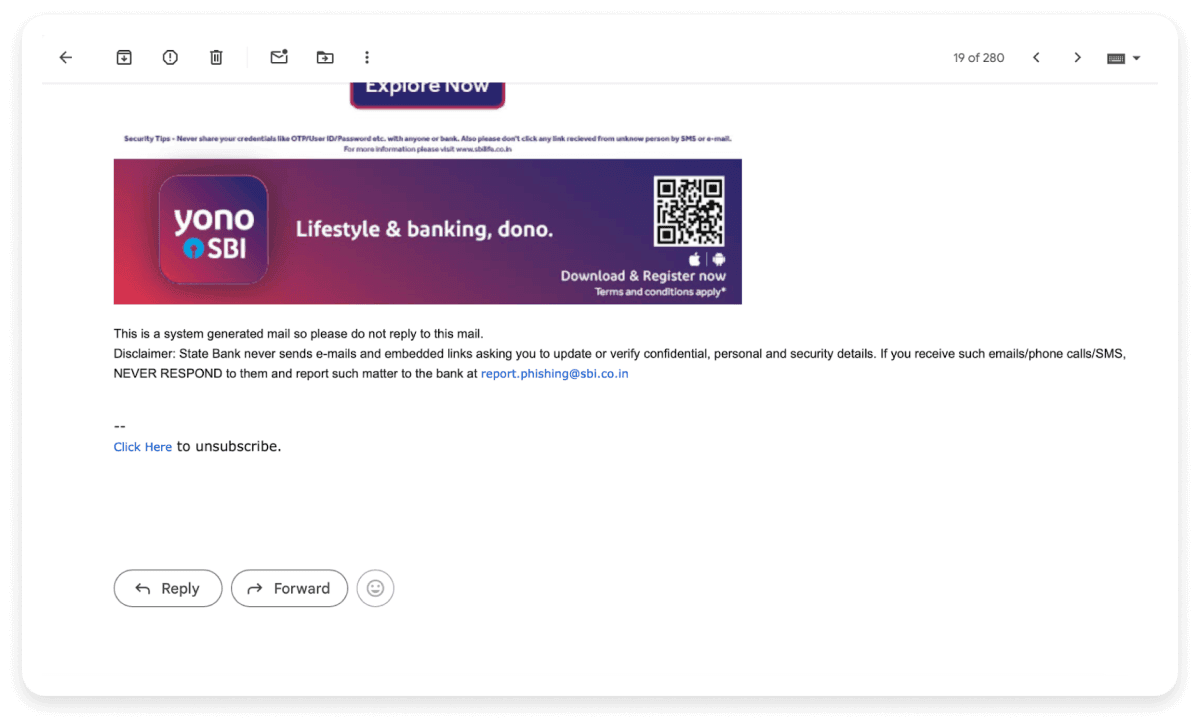
When should you use email disclaimer?
While not legally required in every context, email disclaimers can be important in certain situations. If you're a company that sends emails containing confidential customer data, legal advice, or promotional material, you should have an email disclaimer. Email disclaimers can help protect you from legal liabilities and ensure clarity in communication.
Importance of email disclaimers
Email disclaimers can play several important roles in the emails you send, depending on their usage. Let's take a look at how these email disclaimers can benefit you.
1. Legal protection
An email disclaimer works to limit liability for the sender, especially in case of an email that contains sensitive information, opinions, or advice. For example, the disclaimer may state that any information contained in the email should not be used as legal, financial, or professional advice unless otherwise specifically stated.
2. Confidentiality
Confidentiality disclaimers clearly assert that the email is strictly for the use of the recipient to whom it is addressed and cannot be shared with anyone else without permission, thereby helping to prevent unauthorized disclosure and access. This is especially useful if a company emails sensitive data, like client information or financial reports. In case of a breach, it also shows that the recipient was aware of the confidentiality of the information.
3. Prevention of misuse
Email disclaimers can help prevent misuse by enumerating certain restrictions on how the contents of the email can be used. They may explain that the email should not be forwarded, copied, or acted upon by anyone other than the intended recipient. This is particularly useful for interactions with sensitive information, such as business negotiations, internal discussions, or confidential communications with clients.
4. Liability of virus transmission
Emails are also used to spread viruses or malware, especially those with attachments or links. Whenever a recipient opens an infected attachment, malware can get access to and destroy their systems. A virus transmission disclaimer would protect the sender from liability in the case of an incident of this nature that causes damage by stating that the organization has taken reasonable precautions to avoid virus transmission.
5. Regulatory compliance
Many industries, like finance, healthcare, and legal services, are subject to strict data protection laws(e.g., GDPR, HIPAA) that require businesses to take steps to protect client information. Email disclaimers help companies meet regulatory requirements, especially when handling sensitive information such as financial data, personal information, or medical records.
These protection standards may be illustrated, for example, through an organization incorporating appropriate email disclaimers that explain how an organization treats a recipient's personal information, what rights are available, and how processing is to be carried out.
Common types of email disclaimers
There are multiple types of email disclaimers depending on the purpose of the disclaimer. Let’s go through a few of them, along with a sample for each type.
1. Confidentiality disclaimer
Confidentiality disclaimers emphasize that the information contained is private and should not be spread to unauthorized parties.
Disclaimer: This is a confidential email intended only for the named individual. If you are not the intended addressee, you are hereby notified that any dissemination, distribution, or copying of this email is strictly prohibited.
2. Liability disclaimer
This type of disclaimer aims to release the sender from any form of liability due to any content in the email, claiming it is not formal advice or a legally binding agreement.
Disclaimer: This email and its contents are purely for general informational purposes and do not constitute legal, financial, or professional advice. The views and opinions expressed are those of the author and may not necessarily reflect the views of [Organization]. No representation or warranty is given about the completeness or accuracy of such information, and [Organization] accepts no liability for any loss or damage caused or arising from any reliance on the content of this email. Unless otherwise expressly agreed in writing, this email does not give rise to any binding legal obligations or agreements.
3. Virus transmission disclaimer
This is a type of disclaimer stating that the sender has no liability if viruses or any other kind of malicious software get transmitted via the email’s attachment.
Disclaimer: Although we have made every reasonable effort to prevent virus transmission, the recipient is urged to scan the attachments before opening them.
4. Non-binding nature disclaimer
This disclaimer addresses the point that unless otherwise agreed to in writing, the contents of this email shall not bind either party to a legally binding undertaking.
Disclaimer: This email and any attached files are provided for informational purposes only and are not to be construed as the formation of any legally binding agreement or commitment. By use of this email, nothing shall be implied or created forming contractual and other legal obligations of [Organization], unless explicitly stated in writing and executed and published as such. Specific questions should be addressed to your attorney.
5. Environmental disclaimer
This type of email disclaimer asserts the conservation of the environment by advising that the recipient should not print a hard copy of the email.
Disclaimer: Please consider the environment before printing this email. Think green and reduce paper usage whenever possible.
6. Copyright disclaimer
This type of email disclaimer clarifies that the content of the email is protected by copyright law and should not be reproduced without permission.
Disclaimer: This email and its content are the property of [Company Name] and may not be copied, shared, or distributed without prior authorization.
7. GDPR-compliant disclaimer
A GDPR disclaimer ensures compliance with the General Data Protection Regulation (GDPR) by informing recipients about how their personal data is handled. It emphasizes the organization's commitment to data privacy and transparency.
Disclaimer: This email and any attached files are intended solely for the use of the individual or entity to whom they are addressed. Any personal data included in this email is processed in accordance with the General Data Protection Regulation (GDPR). If you believe you have received this email in error, please notify the sender immediately and delete the email and its contents. For more information on how we process your data, please refer to our Privacy Policy at [insert link to privacy policy].
Legal aspects of email disclaimers
As discussed before, email disclaimers play a very important role in protecting the sender in terms of legal matters. Let’s take a look at the legal aspects of email disclaimers to better understand their role.
1. Jurisdictional variations
Different countries have different laws controlling email disclaimers, especially for mass mail. For instance, what constitutes a valid application of a disclaimer can be significantly different between the United States, the EU, and other jurisdictions. Multinational organizations should, therefore, know the jurisdictional differences and ensure that their disclaimers conform with the demands of the local law.
2. Enforceability and good faith effort
An email disclaimer must meet a number of criteria before it is presented in court. The most basic is that it should, in good faith, ensure that the recipient is aware of what has been communicated.
This means a disclaimer should ensure clear communication with clear words, including a reference to the company’s privacy policy, so that recipients clearly understand the message, especially in the context of the General Data Protection Regulation (GDPR). If it appears somewhere hidden within the email or is in confusing legal terms, it may not hold up in court. In this regard, the more visible and understandable the disclaimer is, the more likely it is to be effective in providing legal protection and maintaining confidentiality.
3. Compliance requirements
Email disclaimers help organizations comply with several laws related to privacy and confidentiality, including GDPR, HIPAA, etc. These mandates demand strict protection of personal and sensitive data and uphold firm standards for data handling.
By including disclaimers, companies inform recipients about how their data will be used, promoting transparency. This not only reinforces the organization’s commitment to its clients but also protects them from legal consequences resulting from data breaches or misused situations.
How to write an email disclaimer
Here are some key tips to ensure your disclaimer is both user-friendly and legally sound.
Keep them short and plain: The body of a disclaimer message should be short and simple. No legal terms that may confuse the recipient should be present.
Position it prominently: The bottom of an email message is the usual and ideal place for placing disclaimers; this keeps them visible with no interference with the main content.
Use consistently and adapt to the audience: Include disclaimers on messages that are dependent on a target audience or on the event. Consistency in all messages will continually reinforce them.
Keep them up to date: Regular updates have the effect of making the disclaimers compliant with the latest developments in terms of legal standards and regulations.
5 Examples of email disclaimers
Looking at popular brands and how they implement email disclaimers can help gain ideas and understand what works best. Here are a few examples, which illustrate the usage of email disclaimers to ensure protection and confidentiality.
1. LinkedIn
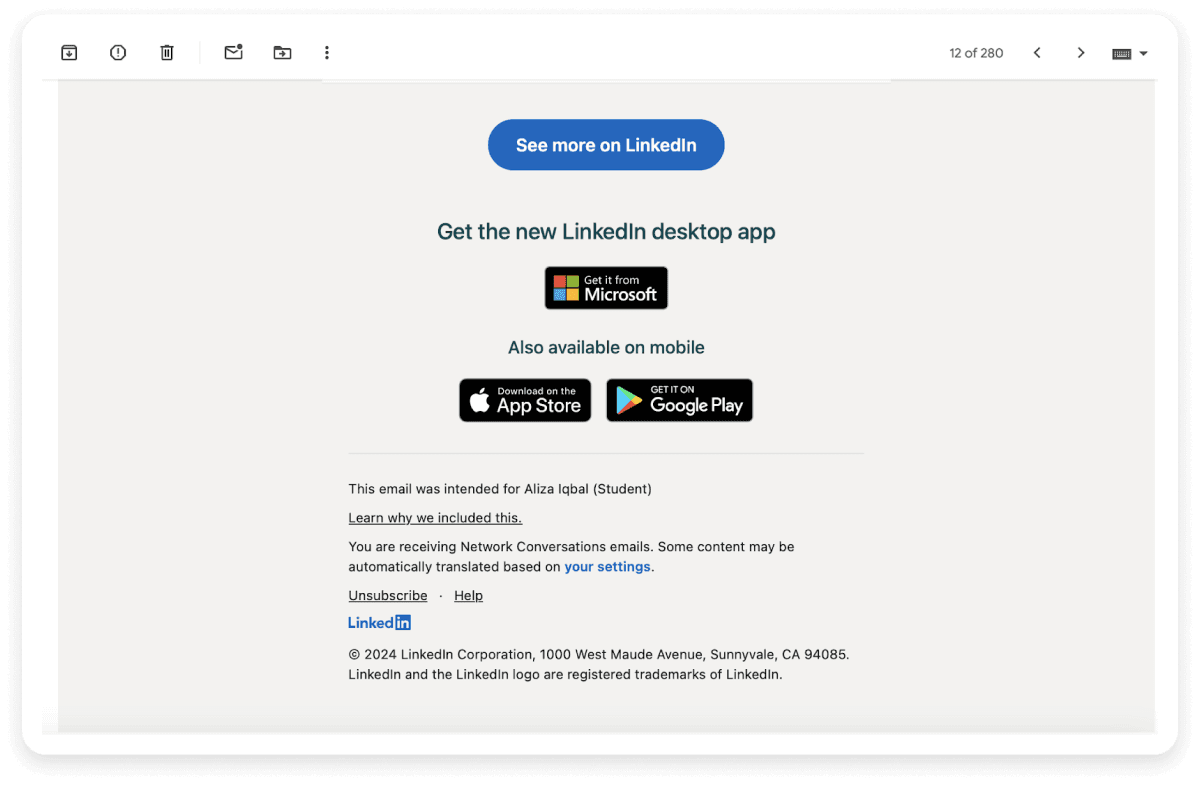
The phrase "This email was intended for Aliza Iqbal (student)" asserts that the email is meant for that particular recipient only. Including such disclaimers is important as it protects the sender by clearly stating who it is intended for, thus minimizing exposure in case the email goes astray. It also communicates to the actual recipient that the email is of a confidential nature, which complies with data protection directives.
2. State Bank of India

This email disclaimer notifies the recipient that replies to this email are not monitored. It is designed in such a way that it would manage expectations and potentially send customers to the proper channels of their support requests.
Additionally, it warns recipients not to respond to suspicious messages. Instead, it advises them to mail reports of phishing attempts on the given contact email. This disclaimer is very important to the customers, as it educates the recipient about the existence of different types of scams and cements the fact that the bank ensures that their information is secured.
3. TripAdvisor
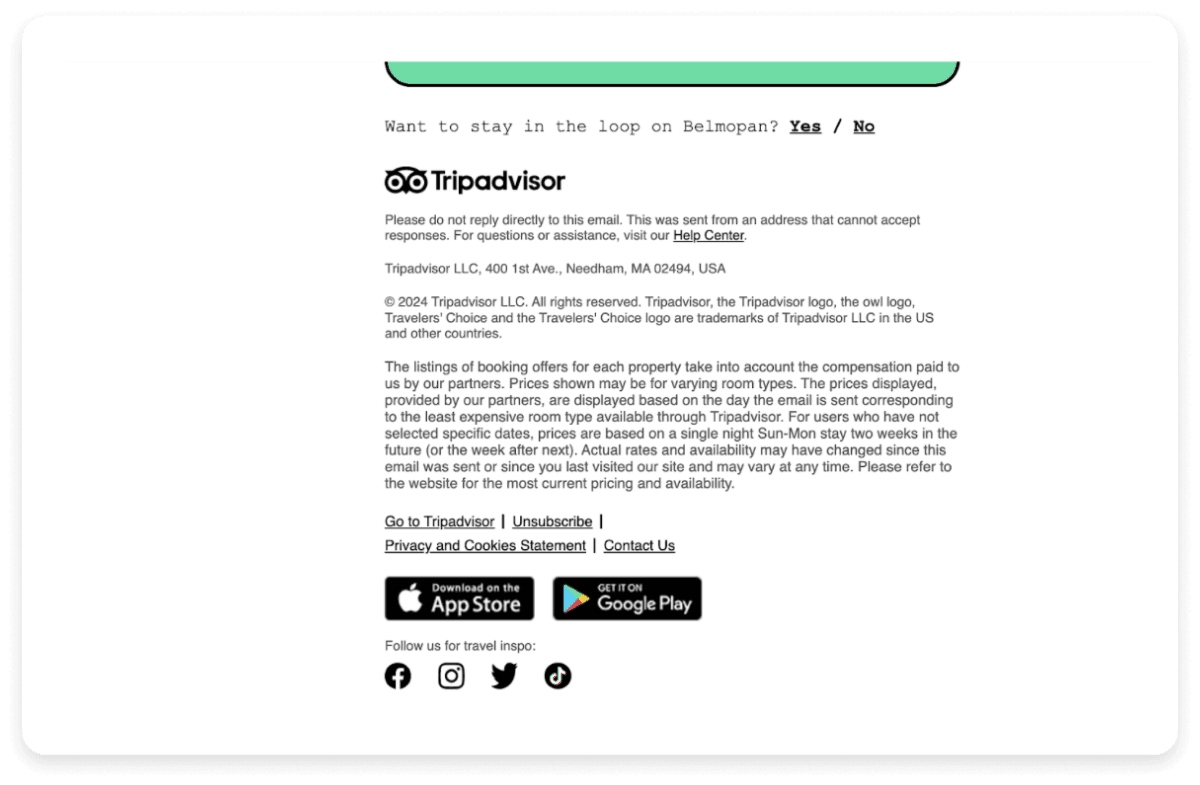
TripAdvisor's email disclaimer includes general information to be kept in mind while booking a hotel. It is mentioned in clear and concise terms to ensure no confusion among users. This disclaimer helps protect both the user and TripAdvisor by clarifying the terms, ensuring privacy, and preventing phishing attempts.
4. Canadian immigration office
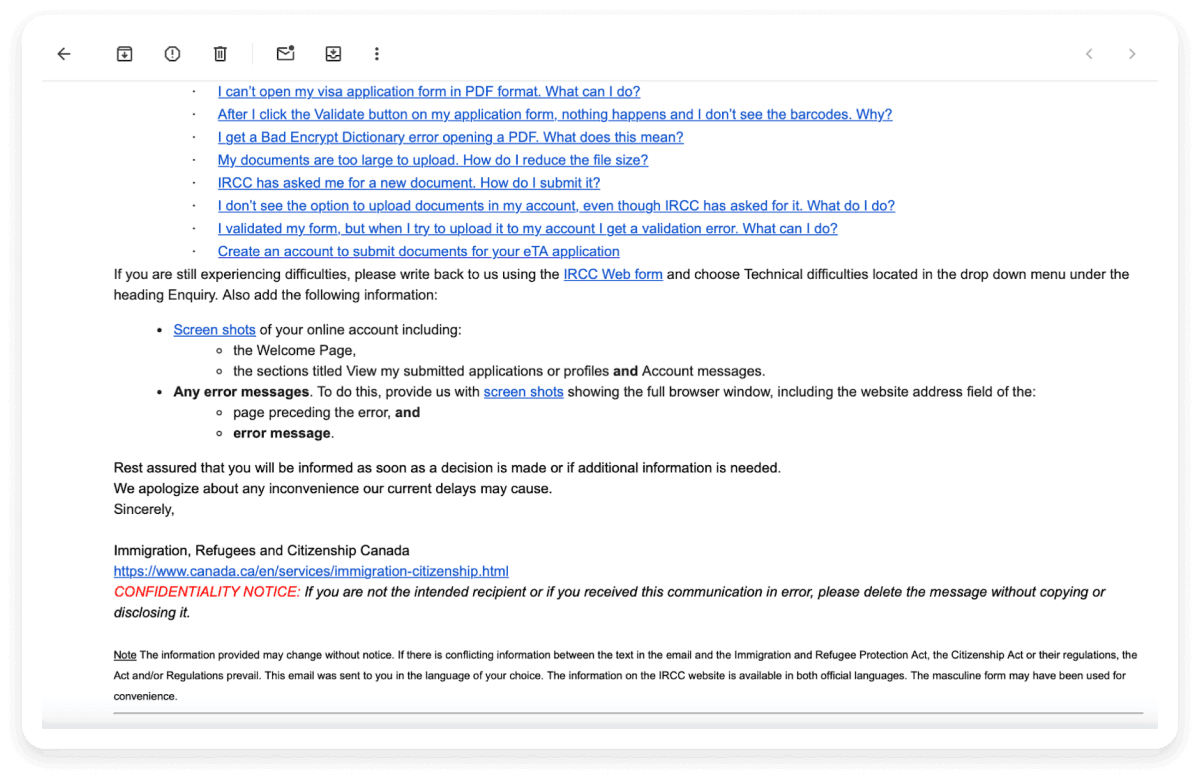
The disclaimer given by the Canadian Immigration Office ensures confidentiality by informing unintended recipients to delete the message and not to disclose it further. It also states that in case the contents of the email contradict actual legislation, the laws take priority. This helps prevent misunderstandings and ensures that recipients are aware of the legal framework governing the information. Further, it mentions the language used and that information is available in both official languages.
5. ICICI bank
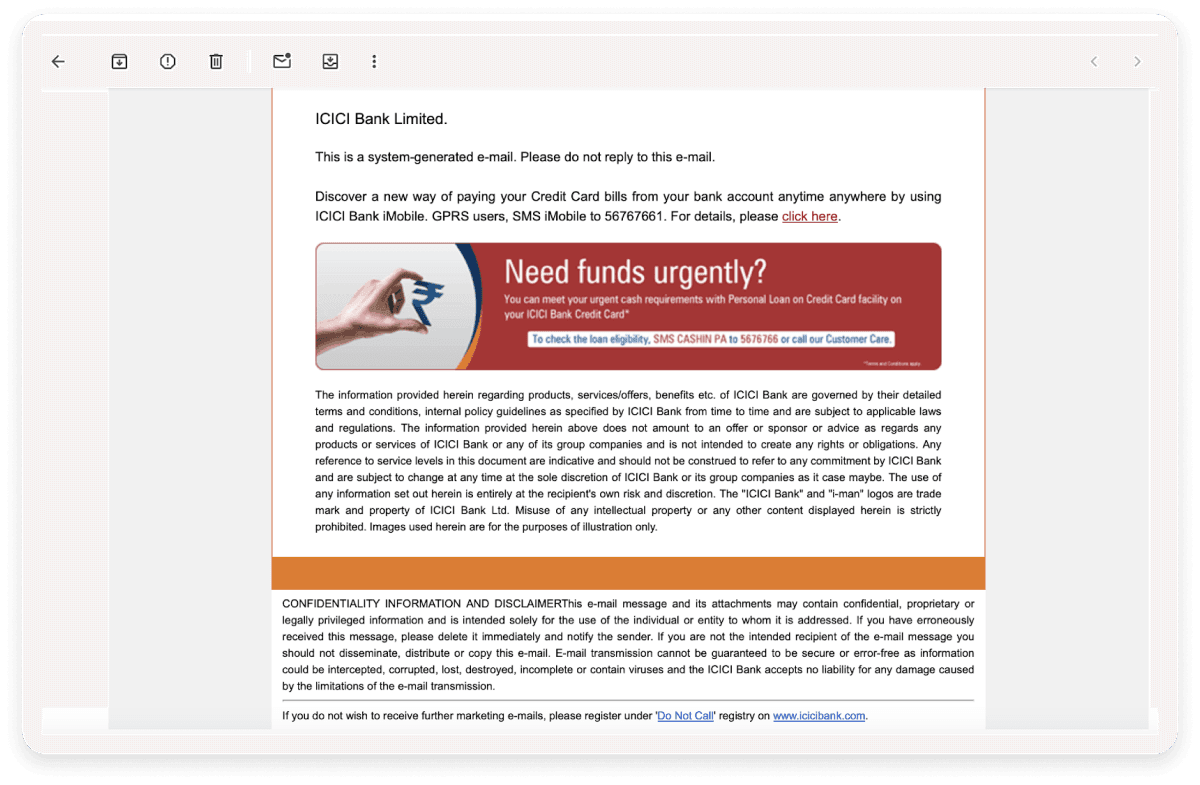
This email disclaimer from ICICI Bank asserts that the bank never solicits confidential information through email, thus saving clients from phishing scammers. The recipients are told that any such solicitation is a fraud; hence, the bank will only request that sensitive information be sent to it through proper authorized secure channels.
Conclusion
Email disclaimer is useful in managing confidential information risk and ensuring compliance with the various legislations. Though it is not applied in every instance, it offers invaluable protection to both the sender and receiver in what is being touted as the digital age of free-flowing information. Now that you understand what email disclaimers are and the different types, you can select the one most suitable for your needs. Follow the steps outlined above to craft your own disclaimers and use the samples for inspiration.































